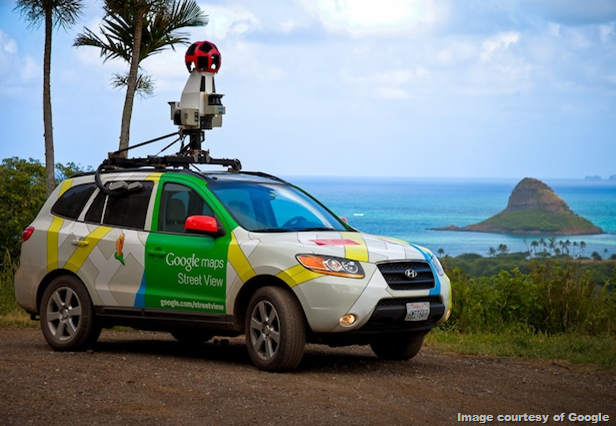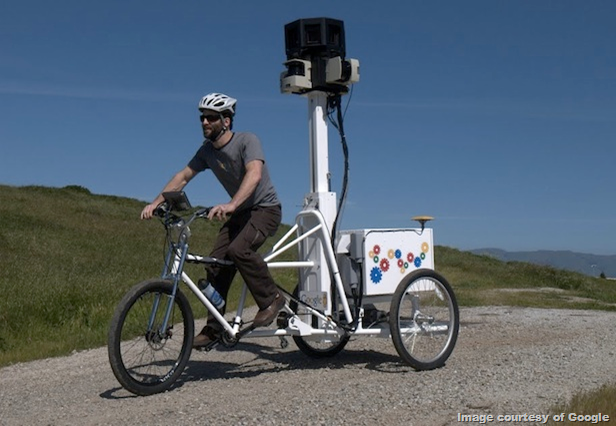Whether you’ve planned a road trip, looked for an aerial view of your childhood home or searched for public transit updates, you’ve probably used Google Maps.
The free web mapping utility allows you to look at street maps, decide between routes, locate businesses and even navigate streets in 3D.
But have you explored the satellite technology behind Google Maps? Do you know about the cameras on top of the Street View cars? Have you heard about something called a “Street View Trike?” Probably not.
We spoke to a Google spokesperson to learn some fascinating, behind-the-scenes facts about Google Maps. Check out the gallery below - you’ll learn what it takes to bring interactive maps of the world to your computer.
Thumbnail image courtesy of Google.
1. How much data has Google Maps accumulated?
Combining satellite, aerial and street level imagery, Google Maps has over 20 petabytes of data, which is equal to approximately 21 million gigabytes, or around 20,500 terabytes.
2. How often are the images updated?
Depending on data availability, aerial and satellite images are updated every two weeks. Street View images are updated as quickly as possible, though Google wasn't able to offer specific schedules, due to its dependence on factors such as weather, driving conditions, etc.
3. How does Google Maps monitor inappropriate content captured on Street View?
According to a Google spokesperson, users occasionally report "odd or unpleasant moments" captured on Google Maps - usually in Street View. The team works quickly to review and take action, if necessary. Users can report an image by clicking "Report a problem" at the bottom of the image, and those requests are regularly monitored and responded to by Google employees.
4. Does Google blur every individual's face?
Google employs automatic face and license plate blurring technology to protect people’s privacy in Street View, and users can even request additional blurring. Aerial imagery provides much less detail and resolution.
5. Who owns the satellites used for aerial views?
The satellite imagery for both Google Maps and Google Earth comes from a broad range of sources and third-party providers. The same information is available to anyone who licenses or purchases it from widely available public, government, commercial and private sector sources.
6. What about private areas?
Those who own the satellites that Google uses may choose to blur certain areas before the satellite and aerial images reach Google. Governments can petition satellite owners to blur certain sensitive geographical areas, as well.
Street View imagery is only available for public roads and private venues through the Street View Partner Program.
7. In which countries can you go inside museums and other buildings via Street View?
Google has worked with thousands of business owners in eight countries to bring Street View technology inside buildings. The Business Photos service is currently available in the U.S., UK, Australia, New Zealand, France, Canada, Ireland and the Netherlands. In addition to various businesses, you can virtually walk around the White House, the Metropolitan Museum of Art and other famous landmarks.
Through the Google Art Project, you can also check out static images of art collections from 156 museums around the world.
8. In the history of Google Maps, how many Street View images have been taken?
The Street View team has taken tens of millions of images since the Street View project began in 2007, and they've driven more than 5 million unique miles of road.
9. What type of camera is used for Street View?
Google originally started with fewer camera lenses and lower quality imagery, but now the Street View camera systems have 15 lenses and can produce photos at about 65 megapixel resolution.
When Street View was still in the experimental stage, the team packed several computers in the back of an SUV and placed cameras, lasers and a GPS device on the roof.
10. How do the images become seamless panoramics?
The 15 lenses in the Street View camera system take photos in various directions, and adjacent cameras on the car take overlapping pictures. The team then aligns the photos and stitches them together to create a continuous 360-degree panoramic image, using imaging techniques to lessen the seams.
11. How does the Google Maps team photograph places where the Street View cars cannot fit or travel?
In addition to the fleet of Street View cars, Google employs trikes, trolleys and snowmobiles. The Trike (pictured) captures parks, trails, college campuses, stadiums and other areas that an SUV can't access.
The Trolley, which looks like a cross between a pushcart and box-shaped robot, is used for navigating a building's interior and doorways.
The Snowmobile captures images across snowy terrains. The team came up with the idea when Vancouver held the 2010 Winter Olympics. The Whistler Blackcomb ski resort was enthusiastic about capturing images of Whistler Mountain.
Related Post: Google Maps: 10 Handy Tricks You Should Know


No comments:
Post a Comment
Please adhere to proper blog etiquette when posting your comments. This blog owner will exercise his absolution discretion in allowing or rejecting any comments that are deemed seditious, defamatory, libelous, racist, vulgar, insulting, and other remarks that exhibit similar characteristics. If you insist on using anonymous comments, please write your name or other IDs at the end of your message.